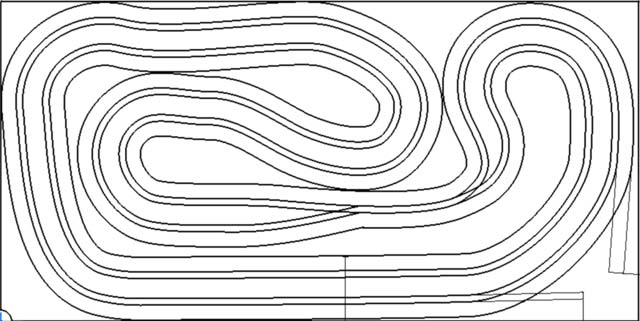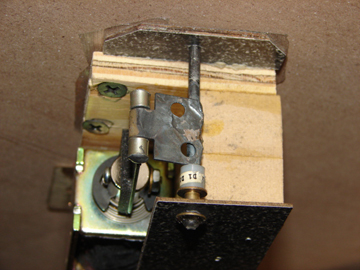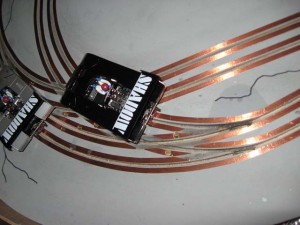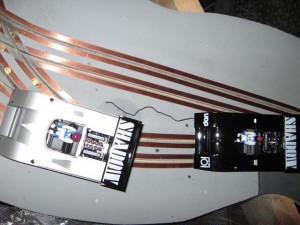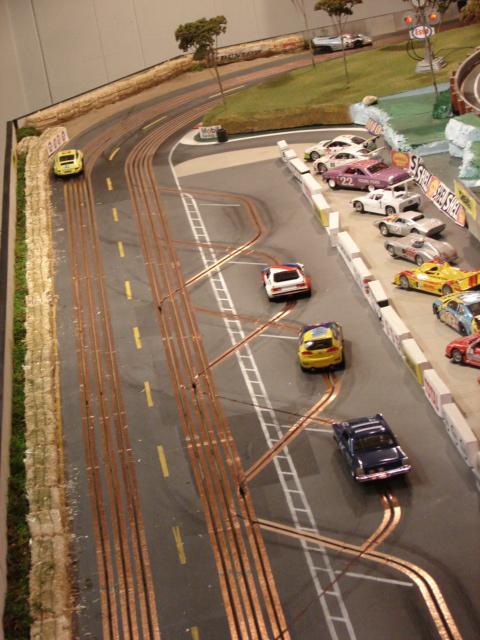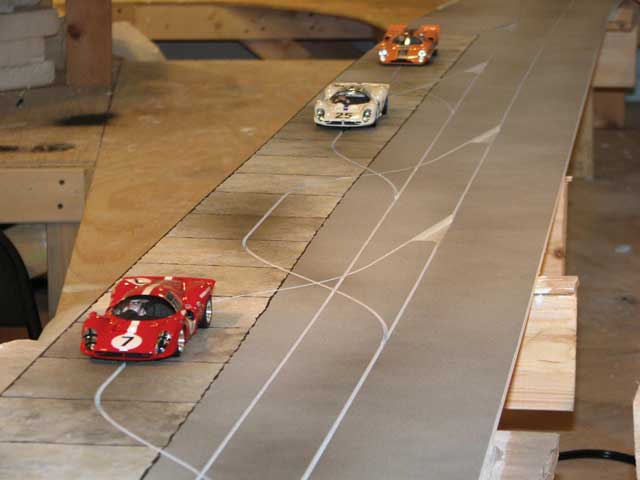Lane Changing
A slot switching primer
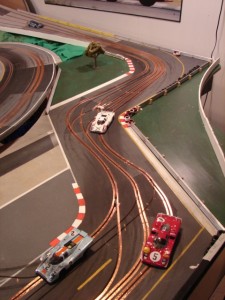 This is a photo showing an AC2Car track with a well designed Lane Change Area.
This is a photo showing an AC2Car track with a well designed Lane Change Area.
Although the copper taping is not completely done, you can see how the field of cars come to the end of a straight and funnel into a chicane. Here the racers will be forced to cue up and pass single file over the Lane Change Switches where drivers can redirect their car to take the inside our outside of the road.
Since the AC2Car system allows two cars to share the same slot, 6 cars can race on this particular track. The mechanical switches beneath the Lane Change Area shown, allows each driver to choose one of two slots that are cut for them around the length of the circuit. This is necessary because changing to an inside or outside lane may be required to pass slower cars blocking on a scale width road course.
By adding a chicane or tight hairpin turn to your track, just ahead of the Lane Change Switches, cars will be going over the switches in single file. This gives drivers the freedom to cut across the roadway without side swiping an adjacent racer whenever he chooses to redirect his car.
Note how the 6 slots funnel down to three slots after the chicane and before the cars pass over the Lane Change Area. This allows a driver, on every lap, to actuate his Lane Change Switch and send his car to do an inside lap of the circuit, or do nothing and the car will continue running in the slot that’s cut on the outside of the roadway.
Also car #2 in the foreground can be seen right over the Pit Enter Switch. A driver actuating this switch as the car passes over, would allow it to turn in for what appears to be a much needed pit stop. Again, note that the pit lane slot and a few other slots in this photo have not been copper taped yet.
Chicane or Hairpin turn
The secret to a good AC2Car routed track with two cars running in the same slot is that it needs to have its lane changing area designed just past a chicane, or hairpin. This way the slots in the track necks down, just before the switches, to force the field of cars to go through slowly in line. This not only minimizes shunts that occur as cars cross other lanes, but it allows the time to make a decision as to whether to stay in the regular lane or cross to the passing lane. Something the plastic tracks cannot provide.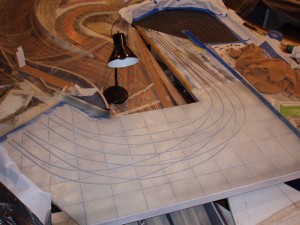
On an AC2Car track, racing 4 cars, each of two lanes has two ways to get around the track, an inner and outer lap. Each lane will run two cars in the same slot, independently controlled. Car #1A and #1B share lane 1, and Car #2A and #2B share Lane 2. All racing independently, blocking and passing by changing over to a second slot cut on the opposite side of the roadway. The track drawing attached, is a perfect example of how the 4 slots come together into two before the cars go over the lane change switches. This forces all 4 cars to run in two slots in single file as they go over their lane changer. This also minimizes side swiping as cars change sides of the road. Both slots fan out, right after their respective lane change switch. This separates the 2 slots back into the standard 4 slot AC2Car pattern. Each lane’s switch either redirects the car to the opposite side, or do nothing and the car will continue in the inner slot. The four controllers are labeled Lane 1A, Lane 1B, Lane 2A and Lane2B Confusing when you just glance over it, but by carefully studying its flow you will better understand its merits. This AC2Car system of track design will give you a far more exciting track to race on.
The way we race, if a slower car is blocking,
- The slow driver really should let the faster car pass. No different than what is expected in real racing!
- The faster car needing to pass should drop back as he comes to the switch because he not only has to negotiate the hairpin turn slowly in single file, but he needs to see which side the car in front decides to choose to race on. If he drops back a bit, no one can pass him from behind because the whole field of cars are forced into single file to get through the tight hairpin or chicane. Like real racing, he sees which side of the roadway the blocking car chooses as it leaves the turn and he takes the opposite side. This careful planning allows him the whole next lap, to beat the other car back to the lane switching area. Each time the cars slow and regroup at the hairpin, or chicane, that decision is made again. No different than what Mario Andretti needed to do at slow turns each lap of every race he ever ran in.
Lane Changing
Rotating Arm Changers
The simple 12 volt solenoid used to pull the bell crank of this home made lane change switch cost less than $4. It can be bought online at alltronics
The best part about this solenoid is that it has a built in return spring. Normally, this spring pressure is what holds the frog, on the track above, pressed to one side in a recess cut for it in the side of the slot. This allows cars to pass straight through. When energized, the solenoid tugs on the linkage rotating the frog out to redirect the car’s shoe into an adjacent slot.
With a bit of ingenuity, rotating lane change switches can be made at home. The rotary switches on Legends and Northline are really simple home made devices.
The “frog” (or as Bryan calls it, “the flipper”) is a railroad term used to describe the mechanism that physically guides a train over to a new track. In our case it is the mechanical means by which the car’s guide flag is redirected.
For my rotating lane changer I used a 1/8″ dia steel welding rod that is hammered flat for about 1 1/4″ where it strikes the passing car’s guide shoe to redirect it into the second slot around the track. This steel rod is bent to form a bell crank that gets tugged and thereby rotated by the solenoid beneath the track.
I welded a hinge to the 1/8 rod for the solenoid to link on to. This assembly forms my mechanical “bell crank” that changes linear movement to rotational movement.
I used kitchen counter, solid surface samples with a hole drilled in it as the bearing surface for the bell crank to pivot in. These free samples from the local home improvement store are thin, cheap, and very hard. They make it easy to adjust the attitude of the bell crank in relationship to the Y in the slots above it.
The 2 Formica samples, glued onto the wood blocks supporting the solenoid, hold the 1/8″ dia steel rod in place allowing it to swivel in the two holes drilled through the Formica. These slip fit holes in the Formica chips act as the rod’s bushings. By slightly shifting the Formica samples around on the wood block before gluing, the steel rod and it’s “frog” can be accurately adjusted to be perpendicular to the top of the Formica chip and get maximum movement by the solenoid.
Temporarily hold the whole switch assembly to the bottom of the track using two faced tape. This allows to still be able to rotate the assembly until the frog is in perfect position to fit the Y in the slots of the track above. Once perfect placement was accomplished then drywall screws were used to permanently fasten the switch assembly to the track.
Even though my lane change mechanism is primitive looking, (Bryan and Dave call it the “Fred Flintstone” design) I’m proud to say that it is an effectively robust design that can be tweaked to fit just right. I made 9 switches of this type to redirect cars on Dave’s Legends International Raceway. They are similar to the 8 switches that have been working on Northline Raceway for about 12 years. Crude, but effective.
Vertical Blade Changers
click here to download a detailed pdf about vertical lane changers
Pivoting Arm Changers

Pit Lane entering
There are two ways that you can create a realistic pit entry. Old Le Mans Style and modern pit road style.
Old Le Mans Style
On the old Le Mans circuit the pits were accessible from the front straight. When cars came to the box they simply drove to the side of the road. Dave’s Legends International Raceway has implemented this type of pit entry and it can be seen in the pictures below. For this style you will need 1 changer for each car.
Modern Pit Lane Style
Second, you can create a seperate pit lane entry for you pits. In this style drivers enter the pit lane from the main track and then enter their respective box from the pit lane. This involves 1 shared changer per car pair on the main track and then a single changer for each pit box. The picture below shows the pit lane of an AC2Car track.
